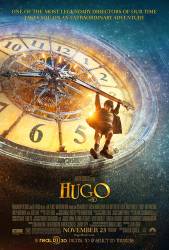Revealing mistake: When the kids see the moon picture on the book, an old, chubby hand lays on the page, obviously not the kids'. When the angle changes, their small thin hands re-appear.
Revealing mistake: At the end of the first chase scene with Hugo, the Inspector and the doberman, Hugo escapes by climbing up and across a train trestle that goes over the tracks. In the overhead shot of Hugo going over the tracks, as he is walking, you can see a safety harness that is coming from his waist and to his left, attaching to a horizontal pole.
Revealing mistake: When the automaton starts drawing, a thick black piece suddenly appears behind the tip of the pen, most likely some sort of mechanism, or a piece of lead to allow for the drawing to be made.





